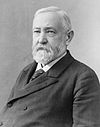
The 38th Infantry Division is an infantry division of the United States Army and part of the Indiana National Guard. It is headquartered in Indianapolis, Indiana, and contains Army National Guard units from across the Midwest.

Fort Robinson is a former U.S. Army fort and now a major feature of Fort Robinson State Park, a 22,000-acre (8,900 ha) public recreation and historic preservation area located 2 miles (3.2 km) west of Crawford on U.S. Route 20 in the Pine Ridge region of northwest Nebraska.
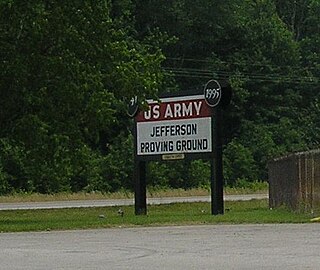
The Jefferson Proving Ground, located near Madison, Indiana, is a former munitions testing facility of Test and Evaluation Command of the United States Army Materiel Development and Readiness Command. The grounds of JPG serve as a wildlife refuge, as well as a gunnery range. Department of Defense organizations and private contractors are assigned to the area.

Fort Harrison, sometimes called Fort Ben, is an Indiana state park located in Lawrence, Indiana, United States, and occupies part of the former site of Fort Benjamin Harrison. The park features a former Citizen's Military Training Camp, Civilian Conservation Corps camp, and World War II prisoner of war camp. There are also picnicking and walking/jogging trails including a connection to the Fall Creek Greenway. The park receives nearly 900,000 visitors annually.

The Defense Information School (DINFOS) is a United States Department of Defense (DoD) school located at Fort George G. Meade, Maryland. DINFOS fulfills the Department of Defense's need for an internal corps of professional journalists, broadcasters, and public affairs professionals. Members from all branches of the U.S. military, DoD civilians and international military personnel attend DINFOS for training in public affairs, print journalism, photojournalism, photography, television and radio broadcasting, lithography, equipment maintenance and various forms of multimedia. Since 1995, DINFOS is accredited by the Council on Occupational Education. The American Council on Education recommends college credit for most DINFOS courses.
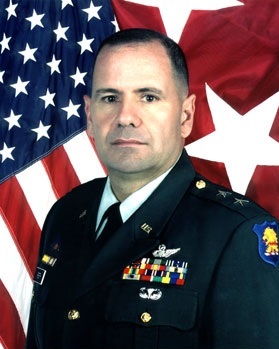
Major General Glenn K. Rieth served as Adjutant General of New Jersey and the commander of the New Jersey Army and Air National Guard, which compose the New Jersey Department of Military Affairs. His service began in March 2002 and ended with his resignation in December 2011.

Fort Douglas was established in October 1862, during the American Civil War, as a small military garrison about three miles east of Salt Lake City, Utah. Its purpose was to protect the overland mail route and telegraph lines along the Central Overland Route. It was officially closed in 1991 pursuant to BRAC action. A small portion of the fort remains in active military use as the Stephen A. Douglas Armed Forces Reserve Center, although it is expected the reserve center will be relocated in the next few years, after the state of Utah provided funds for the purpose in 2023.
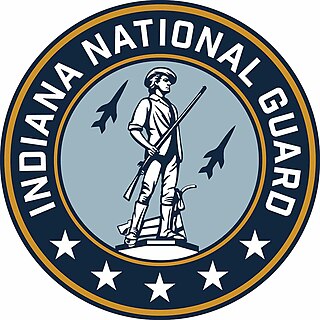
The Indiana National Guard (INNG) is a component of the United States Armed Forces, the United States National Guard and the Military Department of Indiana (MDI). It consists of the Indiana Army National Guard, the Indiana Air National Guard, and the Adjutant General's Office.

Robert Henry Tyndall was a United States artillery officer in World War I, a major general, and mayor of Indianapolis during World War II.

Camp Mabry is a military installation in Austin, Texas, housing the headquarters of the Texas Military Department, Texas Military Forces, and Texas Military Forces Museum. Established in 1892, Camp Mabry is the third-oldest active military installation in Texas, behind Fort Sam Houston and Fort Bliss. It was named for Brigadier General Woodford H. Mabry, the Adjutant General of Texas when the camp was founded. The camp was added to the National Register of Historic Places in 1996.
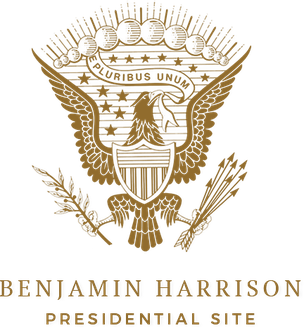
The Benjamin Harrison Presidential Site, previously known as the Benjamin Harrison Home, is the former home of the 23rd president of the United States, Benjamin Harrison. It is in the Old Northside Historic District of Indianapolis, Indiana. Harrison's 16-room house was built from 1874 to 1875. It was from the front porch of the house that Harrison instituted his famous Front Porch Campaign in the 1888 United States presidential campaign, often speaking to crowds on the street. In 1896, Harrison renovated the house and added electricity. He died there in a second-story bedroom in 1901. Today it is owned by the Arthur Jordan Foundation and operated as a museum to the former president by the Benjamin Harrison Foundation.
Citizens' Military Training Camps (CMTC) were military training programs of the United States. Held annually each summer during the years 1921 to 1940, the CMTC camps differed from National Guard and Organized Reserve training in that the program allowed male citizens to obtain basic military training without an obligation to call-up for active duty. The CMTC were authorized by the National Defense Act of 1920 as a compromise that rejected universal military training. In its nearly two decades of operation, the CMTC trained some 400,000 men in at least one season from 1921 to 1940. Overall the program was disappointing, as only 5,000 officer commissions were awarded to men who completed the required four summers of training.
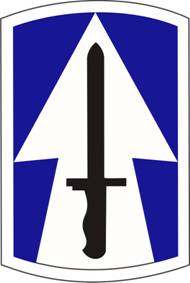
The 76th Infantry Brigade Combat Team is a modular infantry brigade of the United States Army National Guard of Indiana. It is headquartered in Lawrence Readiness Training Center, on the grounds of Fort Benjamin Harrison.
During the American Civil War, Indianapolis, the state capital of Indiana, was a major base of supplies for the Union. Governor Oliver P. Morton, a major supporter of President Abraham Lincoln, quickly made Indianapolis a gathering place to organize and train troops for the Union army. The city became a major railroad hub for troop transport to Confederate lands, and therefore had military importance. Twenty-four military camps were established in the vicinity of Indianapolis. Camp Morton, the initial mustering ground to organize and train the state's Union volunteers in 1861, was designated as a major prisoner-of-war camp for captured Confederate soldiers in 1862. In addition to military camps, a state-owned arsenal was established in the city in 1861, and a federal arsenal in 1862. A Soldiers' Home and a Ladies' Home were established in Indianapolis to house and feed Union soldiers and their families as they passed through the city. Indianapolis residents also supported the Union cause by providing soldiers with food, clothing, equipment, and supplies, despite rising prices and wartime hardships, such as food and clothing shortages. Local doctors aided the sick, some area women provided nursing care, and Indianapolis City Hospital tended to wounded soldiers. Indianapolis sent an estimated 4,000 men into military service; an estimated 700 died during the war. Indianapolis's Crown Hill National Cemetery was established as one of two national military cemeteries established in Indiana in 1866.

Military Park is the oldest urban park in Indianapolis, Indiana, covering 14 acres (6 ha). It is located in western downtown Indianapolis. It was added to the National Register of Historic Places on October 28, 1969.
Stout Army Air Field is located in Indianapolis, Indiana. It serves as the Joint Forces Headquarters of the Indiana National Guard.
The 150th Field Artillery Regiment is a field artillery unit in the Indiana Army National Guard.

The Adjutant General School and the Soldier Support Institute (SSI) are located at Fort Jackson, South Carolina. The school was formerly located at Fort Benjamin Harrison, Indiana, until its closure. These provide training and development of doctrine and organization for Army personnel and administrative operations. Along with the U.S. Army Forces Command (FORSCOM), United States Army Training and Doctrine Command (TRADOC) was created from the Continental Army Command (CONARC) located at Fort Monroe, VA on 1 July 1973. Today, TRADOC is the overseer of training of the Army forces, the development of operational doctrine, and the development and procurement of new weapons systems. The reconstructed Adjutant General Corp Regiment (AG) was created in 1987. The U.S. Army administration and finance specialists are trained at the Adjutant General School located at Fort Jackson. Today's AG Corps serves as human resource (HR) managers for the Army.

Camp Edwin F. Glenn is a national historic district located at Fort Benjamin Harrison, Indianapolis, Indiana. It encompasses 19 contributing buildings and 360 contributing structures in a former military camp. The district developed between about 1925 and 1941. It originally served as a Citizens' Military Training Camp from 1925 to 1941, a camp for the Civilian Conservation Corps from 1933 to 1941, and a Prisoner of War camp from 1944 to 1945. The district includes six warehouses, five mess halls, five lavatories, a branch exchange, butcher shop, latrine, and 360 concrete tent pads.























